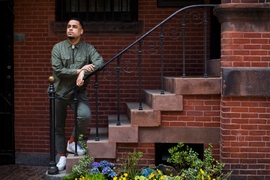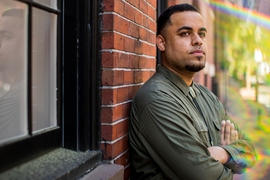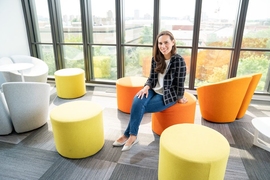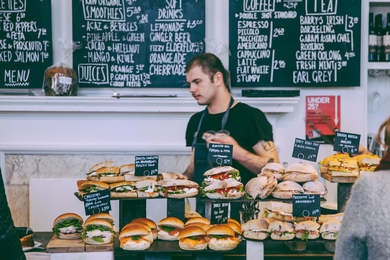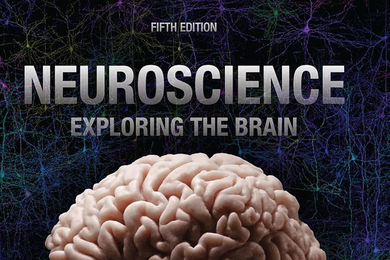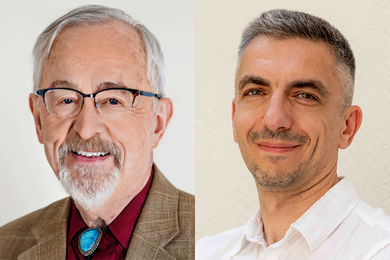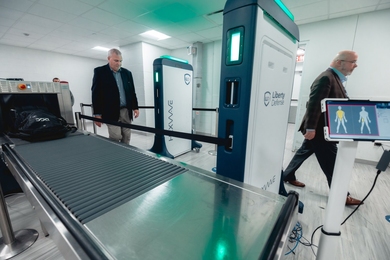“It’s such a weird sort of whiplash,” Darien Alexander Williams says, about how he has felt these past weeks. “It’s been very strange to go from this quarantine life, to crowds of thousands of people, to inhaling tear gas, to writing emails and answering Doodle Polls and finishing up a paper. And then going back out the next night.”
The third-year PhD student in the MIT Department of Urban Studies had just been formulating a dissertation topic chronicling the “messy” urban planning politics of Black Muslim organizations in Boston, when recently documented acts of police brutality ignited Black Lives Matter protests across the world. He has joined the protests, though not directly as part of his research; rather, Williams says he tries to bring his full self, including all of his identities as a young Black queer Muslim disaster researcher, into everything he does. “There’s just inevitability that I will be pulled into the work, even if I didn’t want to be pulled into the work that day,” he says. “It can’t just be a curiosity. I need it to be tangible. From my lived experience.”
Williams also brings his lived experience to his academic research, which focuses on disaster recovery, community organizing, and marginalized populations. A lot of scholarship and national attention focuses more on destruction and trauma in communities of color, rather than the ways those communities have harnessed their power to adapt and organize. “There’s also a tradition of Black people building things, and that is not talked about as much,” he says. “How can I remember that for myself so I understand the communities that I’m a part of and connect to what they’ve done?”
Living within history
Lately Williams has been reflecting on the ways his own family’s history has pivoted around interactions with police and the cities they lived in. His grandmother recounted how shortly after his father was born, she fled Los Angeles under gunpoint by the National Guard in 1965 as her neighborhood burned during the Watts Rebellion. Then right before Williams’s own birth, the Rodney King riots prompted his parents to leave their neighborhood for the suburbs. It was only recently that he began to connect his own childhood of frequent moves, from California to Florida to elsewhere in the country, with the historical patterns of the Great Migration and the reversal of those patterns since the 1970s. “My life is a part of that,” he says.
At first, Williams wasn’t even particularly interested in living in Boston when he arrived at MIT. But then, through community engagement and his faith, he became engaged with the organizing work of Black Muslim communities, including in Roxbury and Dorchester. “I’ve been finding community and learning informally about the lineage of Black Muslim city-building here in Boston,” he says. “Much of that important city-building work, pushed by both towering figures like Malcolm X or less-credited leaders like Sister Virginia Muhammad, is unacknowledged in my own discipline of urban planning. Living in this tension between what the world tells me about itself and what has been written about the world so far is where I’ve found my path as a scholar at MIT and as a member of communities here.”
“I love Boston now,” he adds, although his grandmother has joked that his MIT education should have equipped him to predict that he, like generations before him, would one day be confronting the National Guard in the city streets.
Leaning into weirdness
As a child, Williams said he was nerdy and bookish with a punk goth streak. From a young age, he loved watching the way drag artists disrupted and subverted performances of masculinity, whose confidence in addition to family acceptance has brought Williams to where he is today. “I have agency in choosing how I show up in the world,” he says. “I have agency over having a really good time with how I show up in any space and doing it stylishly and beautifully. Even if that makes certain people uncomfortable.”
Like many an aspiring urban planning student, he challenged himself with rebuilding cities hit by disaster in computer games like “Sim City.” After studying sociology at the University of Florida, Williams lived in Japan for two years and volunteered at a community health center in one of Tokyo’s historically LGBTQI neighborhoods. During that time, he saw how his interest in how cities are built could intersect with his interest in the way marginalized people create space for themselves on their own terms. Williams then earned a masters in city and regional planning at University of North Carolina at Chapel Hill before arriving at MIT.
Now working in the lab on Regional Innovation and Spatial Analysis (LRISA), led by Professor Amy Glasmeier, Williams is currently analyzing the way human error leads to infrastructure disturbances in large-scale pipelines and electric grids, such as the series of natural gas explosions that occurred in the Merrimack Valley in 2018. He also studied emergency management in the wake of Hurricane Michael and presented on it as a fellow of the Bill Anderson Fund, an organization dedicated to expanding the number of historically underrepresented professionals in disaster and hazard research.
He says he likes to blend traditional academic approaches and “weirder” methods in his work, whether that involves incorporating narrative elements into his academic papers, publishing through nonacademic outlets like Undark and Mother Jones, and even acting in “In the Shadows of Ferguson,” a combined research project and multimedia performance piece.
The most joyful part of his research, Williams says, is interviewing people whose knowledge and expertise is invaluable to their communities. “It just feels like a very pure form of learning,” he says. Finding those people requires being open to whatever is happening in the moment. For example, driving around in a rental car on Mexico Beach after Hurricane Michael, Williams stumbled upon a group of people standing in what appeared to be a prayer circle, amongst the rubble. They noticed and waved him over. Spending the day with them, he learned they were a Christian group from a neighboring community, offering support and fellowship to their neighbors. That experience drove Williams to think more critically about why and how faith guides people after a disaster.
Williams initially thought that all of his organizing work would happen outside of the university, but he now serves as a Graduate Community Fellow for the Office of Graduate Education, where he facilitates the Graduate Students of Color Advisory Council (GSOC-AC).
In this role, he is invested in Boston and MIT’s response to demands to defund the police; meanwhile he’s also thinking about the relationship of police to disaster response, and about the start of hurricane season in conjunction with the Covid-19 pandemic. “It keeps me from feeling helpless,” he says. “I don’t have to just sit and deal with it. I have all the tools to at least try to intervene, and that alone keeps me from despair.”
Part of that work is community building, such as the weekly happy hour for Black students in his department and making time for himself: reading, writing with friends, even playing the video game “Animal Crossing New Horizons,” where he participated in virtual Ramadan events and fashion shows and, ever the urban planner, world-building.
“We also just celebrate each other and celebrate ourselves,” he says of his MIT community. “That’s really important for getting through some of the harder parts of each of our lives.”
